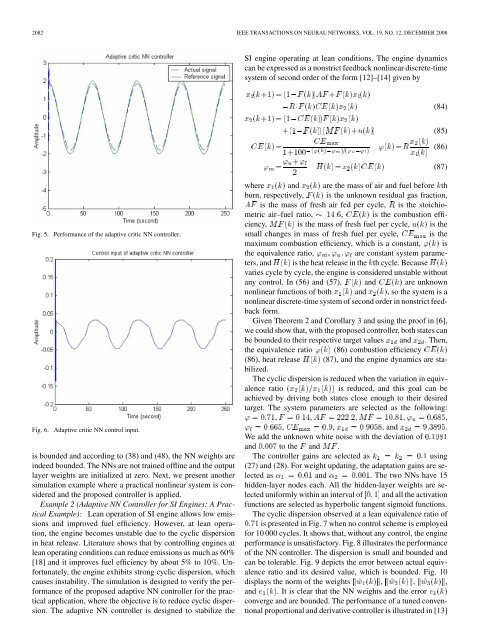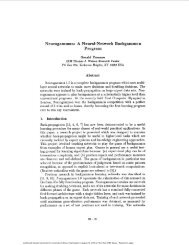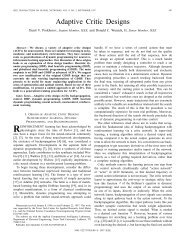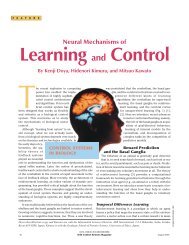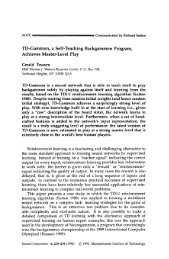Neural-Network-Based State Feedback Control of a ... - IEEE Xplore
Neural-Network-Based State Feedback Control of a ... - IEEE Xplore
Neural-Network-Based State Feedback Control of a ... - IEEE Xplore
You also want an ePaper? Increase the reach of your titles
YUMPU automatically turns print PDFs into web optimized ePapers that Google loves.
2082 <strong>IEEE</strong> TRANSACTIONS ON NEURAL NETWORKS, VOL. 19, NO. 12, DECEMBER 2008<br />
SI engine operating at lean conditions. The engine dynamics<br />
can be expressed as a nonstrict feedback nonlinear discrete-time<br />
system <strong>of</strong> second order <strong>of</strong> the form [12]–[14] given by<br />
(84)<br />
(85)<br />
(86)<br />
(87)<br />
Fig. 5. Performance <strong>of</strong> the adaptive critic NN controller.<br />
Fig. 6. Adaptive critic NN control input.<br />
is bounded and according to (38) and (48), the NN weights are<br />
indeed bounded. The NNs are not trained <strong>of</strong>fline and the output<br />
layer weights are initialized at zero. Next, we present another<br />
simulation example where a practical nonlinear system is considered<br />
and the proposed controller is applied.<br />
Example 2 (Adaptive NN <strong>Control</strong>ler for SI Engines: A Practical<br />
Example): Lean operation <strong>of</strong> SI engine allows low emissions<br />
and improved fuel efficiency. However, at lean operation,<br />
the engine becomes unstable due to the cyclic dispersion<br />
in heat release. Literature shows that by controlling engines at<br />
lean operating conditions can reduce emissions as much as 60%<br />
[18] and it improves fuel efficiency by about 5% to 10%. Unfortunately,<br />
the engine exhibits strong cyclic dispersion, which<br />
causes instability. The simulation is designed to verify the performance<br />
<strong>of</strong> the proposed adaptive NN controller for the practical<br />
application, where the objective is to reduce cyclic dispersion.<br />
The adaptive NN controller is designed to stabilize the<br />
where and are the mass <strong>of</strong> air and fuel before th<br />
burn, respectively, is the unknown residual gas fraction,<br />
is the mass <strong>of</strong> fresh air fed per cycle, is the stoichiometric<br />
air–fuel ratio, , is the combustion efficiency,<br />
is the mass <strong>of</strong> fresh fuel per cycle, is the<br />
small changes in mass <strong>of</strong> fresh fuel per cycle, is the<br />
maximum combustion efficiency, which is a constant, is<br />
the equivalence ratio,<br />
are constant system parameters,<br />
and is the heat release in the th cycle. Because<br />
varies cycle by cycle, the engine is considered unstable without<br />
any control. In (56) and (57), and are unknown<br />
nonlinear functions <strong>of</strong> both and , so the system is a<br />
nonlinear discrete-time system <strong>of</strong> second order in nonstrict feedback<br />
form.<br />
Given Theorem 2 and Corollary 3 and using the pro<strong>of</strong> in [6],<br />
we could show that, with the proposed controller, both states can<br />
be bounded to their respective target values and . Then,<br />
the equivalence ratio (86) combustion efficiency<br />
(86), heat release (87), and the engine dynamics are stabilized.<br />
The cyclic dispersion is reduced when the variation in equivalence<br />
ratio<br />
is reduced, and this goal can be<br />
achieved by driving both states close enough to their desired<br />
target. The system parameters are selected as the following:<br />
, , , , ,<br />
, , , and .<br />
We add the unknown white noise with the deviation <strong>of</strong><br />
and to the and .<br />
The controller gains are selected as<br />
using<br />
(27) and (28). For weight updating, the adaptation gains are selected<br />
as and . The two NNs have 15<br />
hidden-layer nodes each. All the hidden-layer weights are selected<br />
uniformly within an interval <strong>of</strong> and all the activation<br />
functions are selected as hyperbolic tangent sigmoid functions.<br />
The cyclic dispersion observed at a lean equivalence ratio <strong>of</strong><br />
is presented in Fig. 7 when no control scheme is employed<br />
for 10 000 cycles. It shows that, without any control, the engine<br />
performance is unsatisfactory. Fig. 8 illustrates the performance<br />
<strong>of</strong> the NN controller. The dispersion is small and bounded and<br />
can be tolerable. Fig. 9 depicts the error between actual equivalence<br />
ratio and its desired value, which is bounded. Fig. 10<br />
displays the norm <strong>of</strong> the weights , , ,<br />
and . It is clear that the NN weights and the error<br />
converge and are bounded. The performance <strong>of</strong> a tuned conventional<br />
proportional and derivative controller is illustrated in [13]


